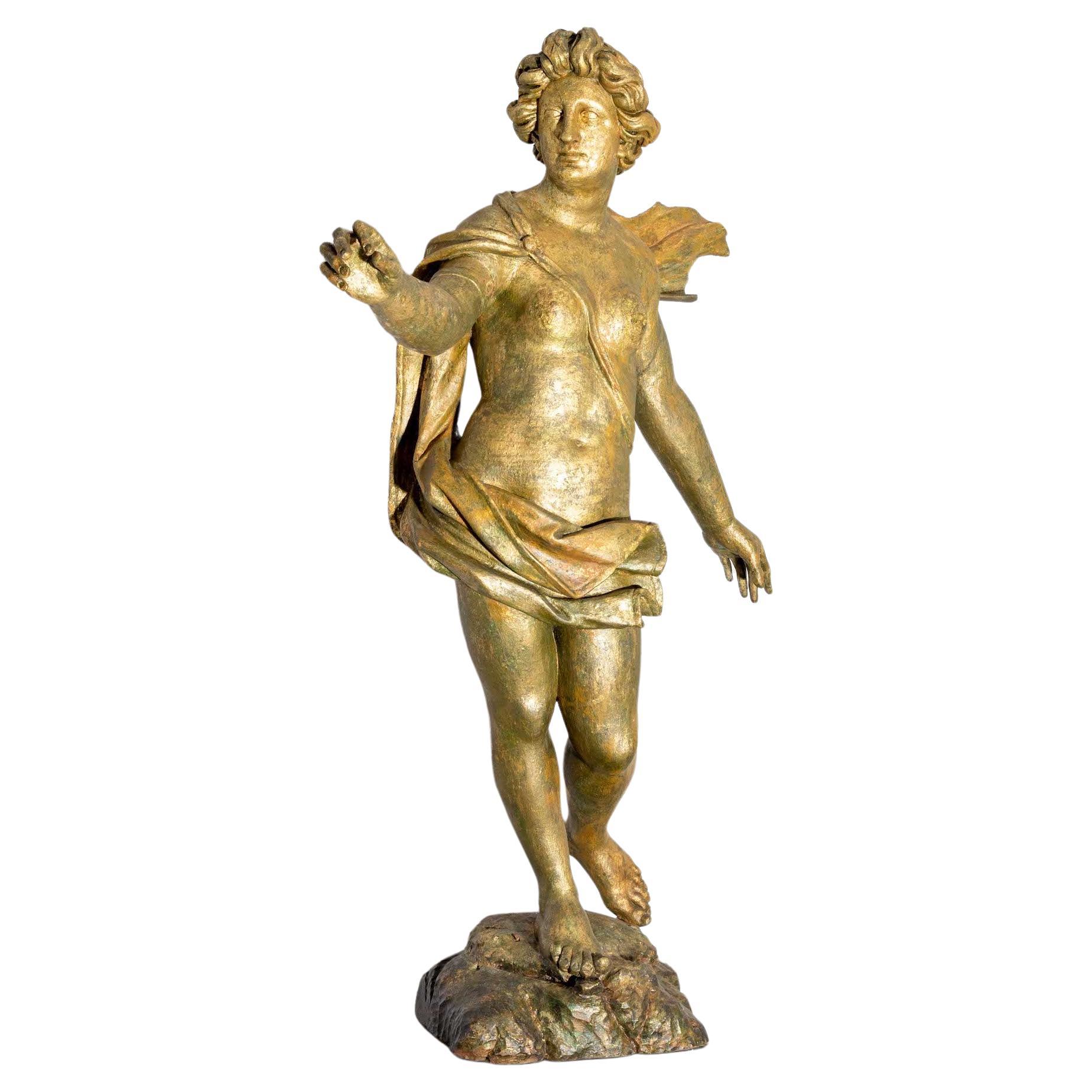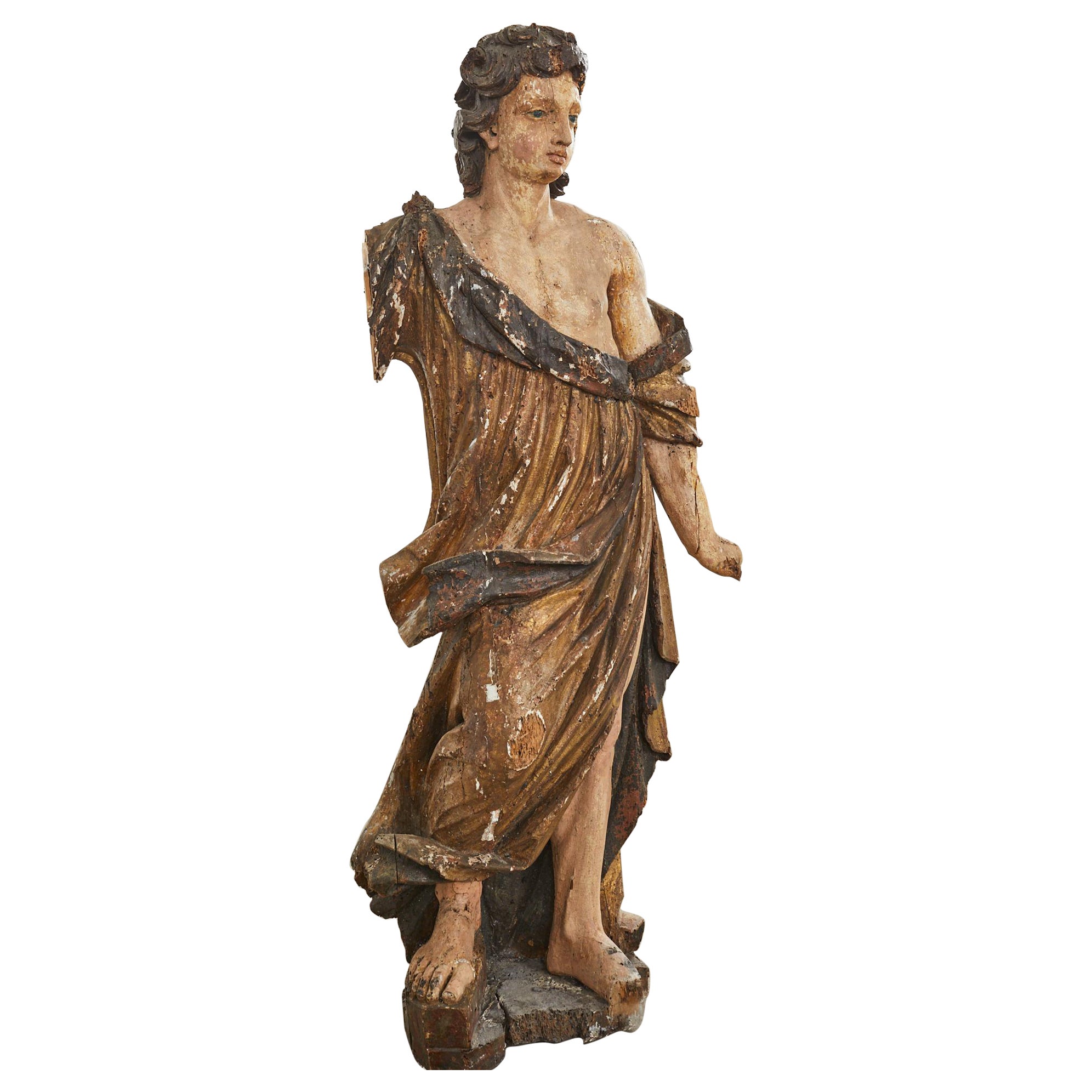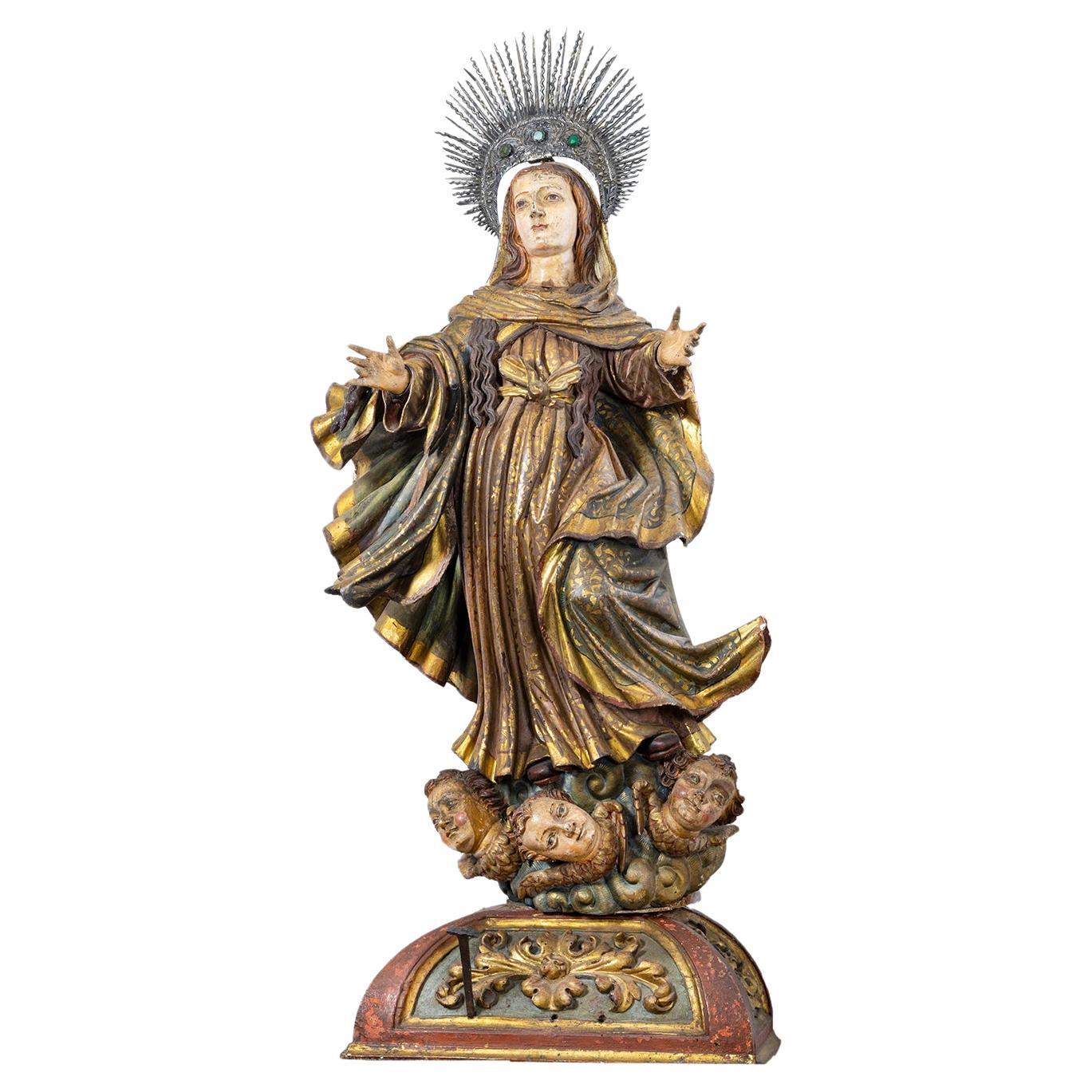Items Similar to Baroque Brazilian Sculpture by Antonio Francisco Lisboa “Aleijadinho” 18th centu
Want more images or videos?
Request additional images or videos from the seller
1 of 17
Baroque Brazilian Sculpture by Antonio Francisco Lisboa “Aleijadinho” 18th centu
About the Item
A very rare Baroque wooden carved sculpture by the Brazilian sculptor Antônio Francisco Lisboa, known as “Aleijadinho” (1738-1814)
Original polychrome detailing
Circa 1790
Height 17.5c
Antônio Francisco Lisboa, was a sculptor, carver and architect of Colonial Brazil, noted for his works on and in various churches of Brazil. With a style related to Baroque and Rococo, Aleijadinho is considered almost by consensus as the greatest exponent of colonial art in Brazil by Brazilian critics and, surpassing Brazilian borders, for some foreign scholars he is the greatest name of Baroque in the Americas.
His recognition goes beyond Brazil. For a good part of modern critics, Aleijadinho represents a unique moment in the evolution of Brazilian art, being a point of confluence of the various social, ethnic, artistic and cultural roots that founded the nation, and more than that, it represents a plastic expression of very high quality of this synthesis, being the first great genuinely national artist.Among many similar opinions, Bazin praised him as the "Brazilian Michelangelo"
The document included is signed and registered by professor Edson Motta, who worked for the Department of National Historical and Artistic Heritage in Rio de Janeiro between the years 1944-1976, he was the leading authority on Brazilian works of arts during this period.
The document is dated and dated by Professor Edson Motta, Rio de Janeiro, 14 December 1970.
Rarely available on the open market
- Dimensions:Height: 6.89 in (17.5 cm)Width: 2.37 in (6 cm)Depth: 3.15 in (8 cm)
- Style:Baroque (Of the Period)
- Materials and Techniques:
- Place of Origin:
- Period:
- Date of Manufacture:1790
- Condition:
- Seller Location:London, GB
- Reference Number:1stDibs: LU6578237536342
About the Seller
No Reviews Yet
Vetted Seller
These experienced sellers undergo a comprehensive evaluation by our team of in-house experts.
1stDibs seller since 2022
- ShippingRetrieving quote...Ships From: London, United Kingdom
- Return PolicyA return for this item may be initiated within 14 days of delivery.
More From This SellerView All
- Pair Superb Chinese 18th Porcelain Double Peacock Platter Famille Rose QianlongLocated in London, GBA Pair of Chinese famille rose 18th century Porcelain double peacock Platters. Qianlong Hand painted in the classic pattern showing a peacock and peahen perched on rockwork in a garden growing with large, lush peony blooms alongside smaller flowers, the octagonal rims enamelled with floral sprays. Country:China Period :Qianlong (1735-1795) Material: PorcelainDimension: 32.5 cm x 23 cm It is known as the "Peacock service", due to the peacocks on the rocks and also as the "Traveler Service"It is a service known as a "traveller", because it was taken from China to Portugal, and from Portugal to Brazil, when John VI, then Prince of Portugal, alarmed by the Peninsular War...Category
Antique 18th Century Chinese Chinese Export Porcelain
MaterialsPorcelain
- Magnificent Sinhalese Portuguese Kastane Rhino Ceremonial Ceylon Sword 17th CLocated in London, GBA magnificent 17th century Ceremonial Sri Lankan Kastane sword with Rhino handle and gold and silver Portuguese inlayed blade. A kasthane is a short traditional ceremonial or decorative single-edged Sri Lankan sword. The sword is featured in the Flag of Sri Lanka. The main aspect of this Kastane Hilts shows the central monster accompanied by supporting minor iconic forms and the peculiar guard arrangement incorporating Buddhist style Vajra quillons. The scabbard of this Kastane sword is made of Rhino horn and is decorated with brass, silver and gold. It is a testament to the skill of the traditional craftsmen operating in Sri Lankas ancient Royal Sword Workshops. The sword measures 75cm in length The Dutch East India Company (VOC or Vereenigde Oost-indische Compagnie in Dutch) regularly gifted swords to the Kandyan court as part of their strategy to protect their trading privileges. Many of these swords had the traditional Sinhalese decoration but with VOC-marked blades. From 1467 to 1818, Kandy was an independent kingdom in Ceylon—present-day Sri Lanka. In the 18th century, the Kingdom of Kandy was recognized for its outstanding metalwork and craftsmanship. Unfortunately, their fine metalworking came to an end when Kandy fell under British rule in the early 19th century. The kasthane served as symbols of rank and office, presented by the king to noblemen and local chieftains. The silver-mounted kasthane was reserved for the Adigar, the highest officials or feudal lords who also acted as ministers and governors. It also served as a diplomatic gift from the court to European visitors. It was a Sri Lankan tradition to wear the kasthane as a symbol of rank to mark ceremonial occasions. However, the sword type, with an animal-decorated hilt and curved blade, was of European origin. It has its roots in the European hunting swords...Category
Antique 17th Century Sri Lankan Anglo-Indian Antiquities
MaterialsSterling Silver
- Antique Rare Early Portuguese Porto Solid Silver Sterling Tazza 40cm SalverLocated in London, GBA Rare Early Portuguese Solid Silver Sterling Tazza in very good condition, hammered silver. Circular top on a tapering flared based foot. There is an armorial to the middle of the...Category
Antique Early 18th Century Portuguese Rococo Sterling Silver
MaterialsSterling Silver
- Early French Solid Silver Sterling Hip Flask 1835 ParisLocated in London, GBA magnificent solid silver and crystal hip flask with weaved wicker half cover. The cup, colar and cork tipped stopper are all hallmarked. In very good condition. The wicker is also ...Category
Antique Early 19th Century French Louis Philippe Sterling Silver
MaterialsSterling Silver
- Antique Ceremonial Ashanti Ghana African Queens Wooden Stool mmaa dwaLocated in London, GBAn antique Ashanti ceremonial stool, carved from a single piece of wood. The up-curved seat stands on five supports, the central one pierced with small semi circles and the outer four supports carved, fretted. In very good condition Length 46cm Height 34cm Width 24cm The origin of the Ashante culture can be found in the Akan ethnic groups that inhabited West Africa around Lake Volta and the Gulf of Guinea. The Asante formed a strong confederation that developed from the late 17th century, with the founding of the city of Kumasi, and whose economy was based on trade, gold mining and slave traffic. They are the most important and larger ethnic group in Ghana and was one of the few African states capable of resisting European imperialism. Within the material heritage and furniture of the Ashante people, some of the most outstanding pieces are the ceremonial stools, being the Golden Stool...Category
Antique Early 1900s Ghanaian Tribal Tribal Art
MaterialsWood
- Max Ackermann Modernist Original Painting Germany 1935 StuttgartLocated in London, GBAn original pastel painting by the German Modernist painter Max Ackermann,(1887 - 1975) He was both painter and graphic artist of abstract works. Signed and dated Born in 1887 in B...Category
Vintage 1930s German Modern Paintings
MaterialsPaper
You May Also Like
- Baroque Sculpture, 18th CenturyLocated in Greding, DEPatinated baroque sculpture on a stylised landscape base in the form of a female figure with a flowing cloak and an expansive gesture. Provenance: Wittelsbach estate.Category
Antique 18th Century Baroque Figurative Sculptures
MaterialsWood
- 18th Century Italian Baroque Carved Santos Icon SculptureLocated in Rio Vista, CAMajestic 18th century Italian baroque polychrome Santos icon sculpture of a young man. The carved icon is depicted standing and wearing a flowing robe with graceful movement. He has ...Category
Antique 18th Century Italian Baroque Figurative Sculptures
MaterialsWood
- 18th Century Baroque Sandstone Sculpture of a Satyr HermLocated in Essex, MAA Period German or French large scale Baroque Garden Statue of a Pan Satyr. Well carved with impish gaze and wrapped in sheepskin Ex Prominent New York Co...Category
Antique Early 18th Century French Baroque Statues
MaterialsSandstone
- Italian Baroque Madonna and Child Sculpture, 18th CenturyLocated in Lisbon, PTA 18th Century superb italian sculpture of a draped Madonna with a veil, base with richly carved relief with cherubs and a baby Jesus on her lap in carved polychrome and gilded wood....Category
Antique 18th Century Italian Baroque Figurative Sculptures
MaterialsGold Leaf
- Immaculate Conception Baroque Sculpture, 18th Century - Religious ArtLocated in Lisbon, PTA rare and unique baroque Spanish sculpture of the Immaculate Conception in polychromed chestnut carving wood and a silver crown, with a original wooden podium...Category
Antique 18th Century Spanish Baroque Figurative Sculptures
MaterialsWood
- Baroque Relicary 18th CenturyBy Europa AntiquesLocated in Madrid, ESBaroque relicary of the eighteenth century important Italian baroque relicary of the eighteenth century entirely carved in wood and gold Measures: 45X30X27 CMCategory
Antique 18th Century Spanish Baroque Mounted Objects
MaterialsWood
Recently Viewed
View AllMore Ways To Browse
Rare Brazilian Furniture
Fo Clock
Jules Felix Coutan
Susse Freres Silvestre
Pharaoh Decor
Plaster Oversized Face
Raffaello Romanelli Portrait Bust
Max Le Verrier Horse
Shou Statue
Bamileke Decorative Wooden Flute
Frank Pollak And Sons
Military Statues
Butterfly Figurine
Le Danseuse
Terracotta Warrior Sculpture
Womans Figure Ring
Putti Figurine
French Standing Sculpture





